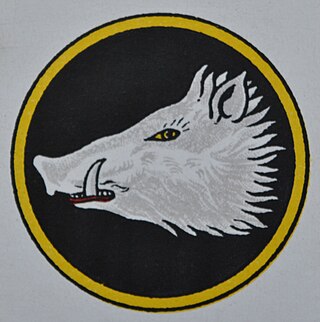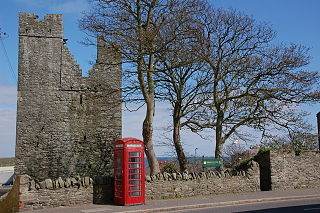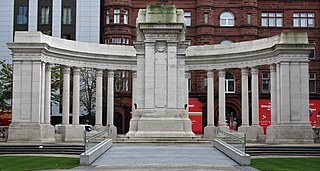
The Battle of the Somme, also known as the Somme offensive, was a battle of the First World War fought by the armies of the British Empire and the French Third Republic against the German Empire. It took place between 1 July and 18 November 1916 on both sides of the upper reaches of the river Somme in France. The battle was intended to hasten a victory for the Allies. More than three million men fought in the battle, of whom one million were either wounded or killed, making it one of the deadliest battles in all of human history.

Newtownards is a town in County Down, Northern Ireland. It lies at the most northern tip of Strangford Lough, 10 miles (16 km) east of Belfast, on the Ards Peninsula. It is in the civil parish of Newtownards and the historic baronies of Ards Lower and Castlereagh Lower. Newtownards is in the Ards and North Down Borough. The population was 28,050 in the 2011 Census.

The 36th (Ulster) Division was an infantry division of the British Army, part of Lord Kitchener's New Army, formed in September 1914. Originally called the Ulster Division, it was made up of mainly members of the Ulster Volunteer Force, who formed thirteen additional battalions for three existing regiments: the Royal Irish Fusiliers, the Royal Irish Rifles and the Royal Inniskilling Fusiliers. However, regular Officers and Soldiers and men from all around the United Kingdom made up the strength of the Division. The division served from October 1915 on Western Front as a formation of the British Army during the Great War.

The 16th (Irish) Division was an infantry division of the British Army, raised for service during World War I. The division was a voluntary 'Service' formation of Lord Kitchener's New Armies, created in Ireland from the 'National Volunteers', initially in September 1914, after the outbreak of the Great War. In December 1915, the division moved to France, joining the British Expeditionary Force (BEF), under the command of Irish Major General William Hickie, and spent the duration of the war in action on the Western Front. Following enormous losses at the Somme, Passchendaele and Ypres, the 16th (Irish) Division required a substantial refit in England between June and August 1918, which involved the introduction of many non-Irish battalions.

Donard Park is a public park located in Newcastle, County Down, Northern Ireland. It is next to the Glen River, which forms the boundary along one side and is at the foot of Slieve Donard, the highest mountain in Northern Ireland, part of the Mourne Mountains. It is owned and run by Down District Council.

The Fourth Army was a field army that formed part of the British Expeditionary Force during the First World War. The Fourth Army was formed on 5 February 1916 under the command of General Sir Henry Rawlinson to carry out the main British contribution to the Battle of the Somme.

Tullyhogue Fort, also spelt Tullaghoge or Tullahoge, is a large mound on the outskirts of Tullyhogue village near Cookstown, County Tyrone, Northern Ireland. It has a depressed centre and is surrounded by trees. It is an ancient ceremonial site where the Chiefs of the Clan O'Neill of Tyrone were inaugurated.

The Ulster Tower, located in Thiepval, France, is Northern Ireland's National War Memorial. It was one of the first memorials to be erected on the Western Front and commemorates the men of the 36th (Ulster) Division and all those from Ulster who served in the First World War. The memorial was officially opened on 19 November 1921 and is a very close copy of Helen's Tower which stands in the grounds of the Clandeboye Estate, near Bangor, County Down, Northern Ireland. Many of the men of the Ulster Division trained in the estate before moving to England and then France early in 1916.

Jordan's Castle is a castle situated in Ardglass, County Down, Northern Ireland. The tower house known as Jordan's Castle is a State Care Historic Monument sited in the townland of Ardglass, in the Newry, Mourne and Down District Council area, at grid ref: J5601 3713. It stands close to the junction of Kildare and Quay Streets in Ardglass and commands the harbour.

Conlig is a village and townland about halfway between Bangor and Newtownards in County Down, Northern Ireland.

The Clandeboye Estate is a country estate in Bangor, County Down, Northern Ireland, 12 miles (19 km) outside Belfast. Covering 2,000 acres (8.1 km2), it contains woodlands, formal and walled gardens, lawns, a lake, and 250 hectares of farmland. Named after the former Gaelic territory of Clandeboye, the estate was the home of Lindy, Marchioness of Dufferin and Ava, widow of the last Marquess, until her death in October 2020.
The Washing Bay is a small bay on the south-west corner of Lough Neagh, in County Tyrone, Northern Ireland. It is in the civil parish of Clonoe, the barony of Dungannon Middle, and the Mid Ulster District Council area.

HQ Northern Ireland was the formation responsible for the British Army in and around Northern Ireland. It was established in 1922 and disbanded, replaced by a brigade-level Army Reserve formation, 38 (Irish) Brigade, in 2009.

The Irish National War Memorial Gardens is an Irish war memorial in Islandbridge, Dublin, dedicated "to the memory of the 49,400 Irish soldiers who gave their lives in the Great War, 1914–1918", out of a total of 206,000 Irishmen who served in the British forces alone during the war.

During World War I (1914–1918), Ireland was part of the United Kingdom of Great Britain and Ireland, which entered the war in August 1914 as one of the Entente Powers, along with France and Russia. In part as an effect of chain ganging, the UK decided due to geopolitical power issues to declare war on the Central Powers, consisting of Germany, Austria-Hungary, the Ottoman Empire, and Bulgaria.

The Belfast Cenotaph is a war memorial in Belfast, Northern Ireland, in Donegall Square West, to the west of Belfast City Hall. Like the City Hall, it was designed by Sir Alfred Brumwell Thomas. The cenotaph was unveiled in 1929. It became a Grade A listed building in 1984.

Operation Michael was a major German military offensive during the First World War that began the German Spring Offensive on 21 March 1918. It was launched from the Hindenburg Line, in the vicinity of Saint-Quentin, France. Its goal was to break through the Allied (Entente) lines and advance in a north-westerly direction to seize the Channel Ports, which supplied the British Expeditionary Force (BEF) and to drive the BEF into the sea. Two days later General Erich Ludendorff, the chief of the German General Staff, adjusted his plan and pushed for an offensive due west, along the whole of the British front north of the River Somme. This was designed to first separate the French and British Armies before continuing with the original concept of pushing the BEF into the sea. The offensive ended at Villers-Bretonneux, to the east of the Allied communications centre at Amiens, where the Allies managed to halt the German advance; the German Army had suffered many casualties and was unable to maintain supplies to the advancing troops.

The revolutionary period in Irish history was the period in the 1910s and early 1920s when Irish nationalist opinion shifted from the Home Rule-supporting Irish Parliamentary Party to the republican Sinn Féin movement. There were several waves of civil unrest linked to Ulster loyalism, trade unionism, and physical force republicanism, leading to the Irish War of Independence, the creation of the Irish Free State, the Partition of Ireland, and the Irish Civil War.

Woodvale Park is a park in Belfast, Northern Ireland. Opened in 1888 and run by the city council, it provides a venue for association football and bowls as well as a children's play area and landscaped areas for walking. The park is home to the Peace Tree, an oak planted in 1919 to commemorate the end of the First World War, which was voted Northern Ireland's Tree of the Year for 2015. The European War Memorial honouring those from all sides killed during the First World War was unveiled in the park in 2014.

The War Memorial Building is a grade B2 listed building in Belfast, Northern Ireland. The building, modernist in design, was constructed in 1959–1962 on the site of a hotel destroyed during the 1941 Belfast Blitz. The building was formally opened by Queen Elizabeth The Queen Mother and housed organisations and charities related to the British armed forces. The site currently lies empty and has been placed on the Heritage at Risk Register. The current owners have applied for permission to convert the building into a 120-bedroom hotel.



















